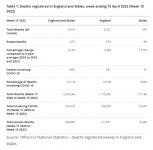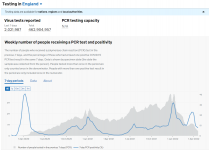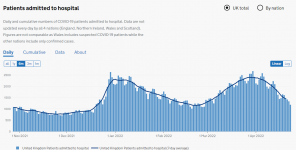I don't look at Covid deaths in isolation, it's pointless when we're effectively no longer in excess, and saving a massive chunk of deaths to off set them. We're saving deaths from somewhere (maybe that we've already killed a lot of the vulnerable), but we get more overall more mortality in winter (Jan is 30% more than August for example (12k per week v 9k per week), EWM (excess winter mortality etc), a lot of that is Flu and other seasonal problems.
We're no 6% better off than the 5 year average, 10% of deaths involve C19, so we're saving ~16% of deaths from somewhere. As there's no Flu (outcompeted) then this will take a chunk of it.
If we're below excess, then I don't see how additional measures are needed (v the social and economic impact they cause), the risk rating is already better than it would normally be for a comparative week, over a typical 5 year period. The additional measures make even less sense, if you were not advocating being much, much stricter with the first lockdown, Christmas and other measures etc, and not many on here were asking for that (I was btw, as it mattered far, far, far more then).
Plus, measures V BA2 on even a semi open society will have next to nil effect, it's just too transmissible (BA1 and Delta the same to a lesser degree). Big, big difference to the wild type which could have been stopped, or massively reduced quickly and easily if we acted early and never let it get out of hand.
Cloth and surgical masks will help probably less than 2% with BA2, and 1% of a low number below excess is a bit pointless, and also just delaying the inevitable, nobody active is avoiding being exposed, it's just not possible. Paying people to be at home if they're low risk, seems counter productive at a time with a struggling economy, but I do agree we should support those who really need it most. They also should be protecting themselves with FFP3/ respirators when out in public. I don't think the public should be paying to support people who won't take reasonable measures to protect themselves better. Ie expecting the public to pay for a guy to have time off, is asking a lot, if he's going down the pub three days a week.
We should have supported more people, and better prior to vaccines and with the more damaging waves though, which I've said all along.
Mortality doesn't need to come down, we're 6% lower than the bar already (comparing to non-covid years). Also test positivity rates have been dropping for a month, it's already being controlled enough, we're at pre omicron levels and it's still going down. Test positivity is probably the best measure to use now that testing numbers and cases are all over the place.
I think people should still isolate if showing symptoms, in most circumstances, and I think a lot would anyway (which will be factored in to policy hopefully). But don't see much point in isolating if you're meeting people who have already had covid, been vaccinated and if you inform people who you're meeting that you've had it (and they're ok with it).
Covid deaths are dropping quickly, as are admissions, we're doing enough (as a whole).
View attachment 37934
View attachment 37935
View attachment 37936
View attachment 37937
View attachment 37939
View attachment 37941








